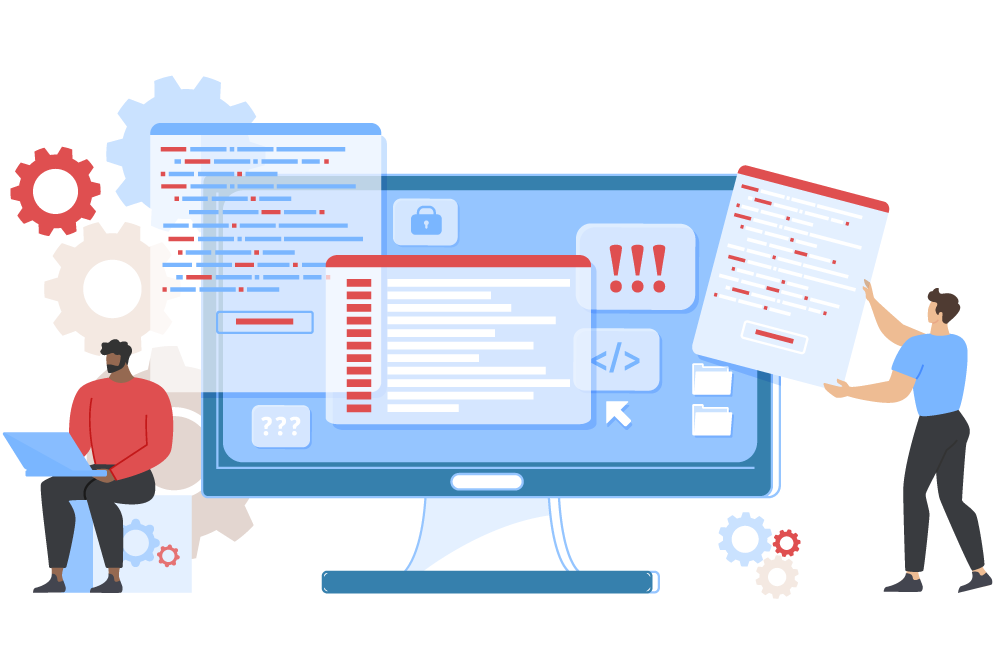Excellent Reasons On Picking application development with Low-code platforms
Wiki Article
Accessibility Of Low-Code Applications Is One Of The Biggest Benefits.
The following key factors make low-code development accessible to non-developers.
Drag-and-Drop Builders : Low-code platforms offer drag-and–drop interfaces which enable non-developers, without the necessity of writing code, to create visually appealing applications. This makes development more accessible to people who have little or no technical expertise.
WYSIWYG Editors: "What You See Is What You Get" editors allow users to design interfaces and workflows in a manner that closely resembles the actual product, which makes it much easier to understand and use.
Simplified Logic and Workflow Design:
Visual Workflow Modeling: Users can develop business processes and logic for applications using visual flowcharts or models. This is a lot more simple than traditional programming methods.
Pre-built Logic Components: Low-code platforms usually have pre-built logic elements (e.g. statements that are conditional loops) that can be easily modified, eliminating the requirement for complicated coding.
Reusable Templates and Components
Library of pre-built templates: A lot of Low-Code platforms provide a collection of templates based on typical application types. Non-developers will be capable of modifying these templates if needed.
Reusable Modules and Widgets With the help of the reuse of modules and widgets users can speed up the creation process and reduce the requirement for technical knowledge.
Tutorials and guides for development:
Step-by-Step Guides: Platforms often provide a development path that is guided as well as tutorials and on-screen tips to assist non-developers in creating applications.
Interactive Tutorials: Interactive, hands-on tutorials help users learn by doing, improving their knowledge and confidence using the platform.
Integration with existing tools:
Easy Integration - Low-code platforms can be easily integrated with existing systems and tools for business (e.g. ERP CRM), allowing even non-developers the ability to build apps that are compatible into their workflows.
APIs Connectors: APIs are built into applications to simplify integration. This allows non-programmers, with no programming skills, to connect to external services.
Collaboration Features:
Team Collaboration - Features like real-time collaboration between teams and shared workspaces enable non-developers to work effectively alongside analysts, professionals, analysts, and the other stakeholders.
Role-based Access Control: Non developers can be assigned roles with the appropriate access levels. This lets them participate in the development process without compromising security or functionality.
Automated Testing & Debugging
Low-code platforms are often equipped with testing and debugging software that automatizes these procedures. This makes it simpler for non-developers to check their applications function correctly.
Error highlighting: The platform highlights issues and suggests fixes to help non-developers.
The primary benefit of low code application development in terms of accessibility to non-developers stems due to its ability to decentralize the process of development. With its visual-friendly tools and experiences, low-code platforms enable business owners to actively participate and maintain applications. Follow the top rated Low-code Platform for application development for website recommendations including build with docker, no code platforms, app modernisation, azure sql server, develop mobile application, stored sql procedures, cross platform mobile app development, multiplatform mobile app development, app modernization, multiplatform mobile app development and more.

Flexibility And Scalability Are Two Advantages Of Low-Code Application Development
Low-code application creation offers several benefits, especially in terms scalability. It is essential to develop applications that expand with your company and can adapt as it grows. Here are the main advantages: Rapid Scaling
Cloud-based deployment. Many low-code platforms feature a cloud-based deployment that allows the scaling of applications with cloud infrastructure. This lets businesses handle the increased demand without worrying about managing servers.
Auto-Scaling Features: Built-in auto-scaling features allow for automatic adjustment of resources according to demand, which ensures the same performance even during peak hours without any manual intervention.
Flexible Architecture:
Modular design: Low-code platforms are a fantastic way to encourage modular applications. These allow components to be developed independently and tested, scaled or even resized. This modularity is a great method to improve flexibility. It also makes it easy to modify and expand the functionality of an application without having to have the entire application affected.
Microservices integration: The ability to support microservices architecture allows applications to be built as a collection of loosely coupled services. This improves capacity and flexibility.
Customizable solutions:
Flexibility : Low-code platforms allow developers to enhance functionality beyond the standard features. This allows for the fulfillment of specific business requirements without restrictions.
Third-Party Integrations: The ability of businesses to integrate third-party applications and APIs and add new functionalities to the application when required, expands the capabilities of the application.
Agile Development & Deployment
Continuous Deployment and Delivery: Low-code platforms can be used to implement agile processes, allowing continuous deployment and integration (CI/CD). This enables rapid delivery of updates and new features, allowing apps to grow quickly in response to the feedback of users and changes in the market.
Iterative Development: The iterative nature of development using low-code ensures that applications can be incrementally improved and scaled, reducing the risk associated with large-scale changes and allows for greater control over growth.
Resource Optimization
Efficiency in Resource Management: Low-code platforms allow you to maximize the use of resources by offering tools for monitoring and managing application performance. This makes sure that resources are used effectively and can be scaled according to the needs of the user.
Load-balancing: Features that spread workloads equally across servers enhance the application’s ability to handle large volumes of traffic and ensure a consistent performance.
Global Reach
Multi-Region Accessibility: Lowcode platforms allow for deployment across multiple regions. Businesses can offer users low-latency worldwide access. This is particularly important for apps that have a large global user base.
Localization: Support for localization is integrated into the software, allowing applications to be modified to accommodate different languages or regional requirements. This enhances flexibility for different markets.
Maintenance and Updates:
Simplified Maintenance: The graphic and modular design of low-code applications simplify maintenance tasks which allows bugs and updates to be implemented quickly without extensive downtime.
Version Control: The integrated version control system helps control changes and roll backs. This makes sure that updates are easily deployed and previous versions restored when needed.
Cost Efficiency:
Low Development Costs - By decreasing the amount of programming needed, low-code platforms can cut down on the development cost. This makes it possible to scale up applications without needing to increase the development effort and expenditure.
Pay-As-You-Go Models A lot of low code platforms have flexible pricing options like the pay-as-you-go model, which aligns costs with actual usage and growth. This provides financial flexibility.
Overall, low-code app development provides businesses with the flexibility and scalability they need to build robust and flexible apps. These platforms are able to quickly adapt to the changing needs, make efficient use of resources, and continually improve, allowing apps and companies alike to grow and grow. Take a look at the recommended Legacy application modernization with Low-code for blog examples including cross platform app development, develop web app, rapid action development, application modernization software, lowcode no code, sso azure, mobile development platforms, azure sql databases, multiplatform mobile app development, app platforms and more.

Benefits Of Low-Code Application Development In Terms Of Community Support And Vendor Support
Low-code platform development offers significant advantages, such as vendor support and community. This is crucial to ensuring successful application implementation, ongoing maintenance and continuous improvement. These are the main benefits: Support
Comprehensive Technical Support:
Support Teams: Many Low-Code platforms provide access dedicated support team who assist with technical issues, guidance and troubleshooting.
Certain vendors offer support 24 hours a day. This is advantageous for companies operating in different time zones.
Training and Onboarding
Structured training programs: Vendors provide structured courses such as webinars and certification courses. This allows users to quickly grasp the platform.
Customized Onboarding : Many providers offer customized onboarding that help new customers to implement the platform and customize it according to their specific requirements.
Regular Updates and Enhancements
Continuous Improvement: Low code platforms provide regular updates that include new security patches, features and improvements to performance. This helps ensure that the platform remains current and safe.
Feedback Integration Vendors incorporate customer feedback into the development process to ensure that the platform evolves to meet changing needs.
Comprehensive Documentation:
Documentation: Comprehensive documentation is offered for all products. It includes everything from basic to advanced customization. It helps users locate solutions on their own.
API References: Comprehensive API documentation aids developers to integrate the low-code platform into other systems and to customize their applications to be effective.
Professional Consulting Services
Expert Consulting. Vendors offer a wide range of consulting services, including the design of architecture as well as strategic planning, and even complex platform implementations. They ensure that customers can maximize the potential of their platform.
Custom Development Services - Certain vendors offer customized development services to help with specific capabilities or integrations that are not offered from the standard package.
Community Support for the Community
Active User Communities
Forums and Discussion boards A number of low-code platforms have lively online communities that allow users to share ideas, discuss questions and collaborate.
Local and virtual User Groups These groups provide opportunities to network, learn and share your experiences.
Knowledge Sharing & Collaboration:
Community-Contributed Resources: Users often share templates, modules, and extensions that they have developed, which can be reused or adapted by others, accelerating development and innovation.
Crowdsourced Solutions: The collective knowledge, experience and expertise of a community can prove to be a useful tool in troubleshooting and finding creative solutions.
Learning and Development:
Community-led training: Many communities offer webinars, workshops, and training sessions facilitated by knowledgeable users.
Online Tutorials and Courses Community members develop and publish tutorials, online courses and how-to guides. This helps improve the learning tools that are accessible to the users.
Feedback and Influence
Product Feedback Channels Community forums include many channels to provide feedback to vendors, which can influence the design of features.
Beta Testing Programs: Active members of the community may be eligible to participate in the beta testing program. They will get an early glimpse of new features, and an opportunity to shape the evolution of the system.
Recognition and Support
Many companies offer community recognition programs. These programs honor active community members and include MVP programs.
Peer Support. Community members provide peer support. They share their knowledge with users who are less familiar and provide guidance. This creates an atmosphere of collaboration and support.
In general, the combination of solid vendor support, as well as an active and engaged community creates a broad ecosystem of support for development with low-code. The combination of strong vendor support and an active, engaged community provides a comprehensive support ecosystem for low-code application development.
